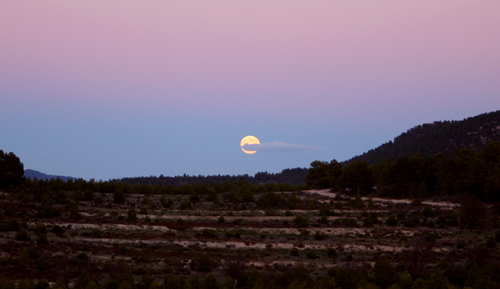Full Moon, I saw you standing alone…

Although it takes only 27.322 days on average for the Moon to complete one orbit around the Earth (the sidereal month), as a result of the Earth’s orbital motion around the Sun it requires about two additional days for the Earth, Moon, and Sun to acquire the same relative geometry. So on average the number of days between two similar phases (e.g., between one full moon and the next full moon) is about 29.531 days. This period is referred to as a lunation, lunar month, or synodic month. The actual number of days in a lunation can vary from about 29.272 to 29.833 because the velocities of the Moon and of the Earth are not constant in their elliptic orbits, and because of gravitational interactions with other bodies in the solar system.
Because the month of February has only 28 days (or 29 in a leap year), there have been a few occasions during which this month has been without a full moon. In particular, there was no full moon in February of 1866, 1885, 1915, 1934, 1961 or 1999. There will be no full moon during February of 2008. In these years, there were instead either two full moons in January, March, or both (as in 1999). In the leap year of 1972, there was a full moon on February 29. The previous February 29 full moon occurred in 1820 and before that in 1752.
A full moon is often thought of as an event of a full night’s duration. This is somewhat misleading, as the Moon seen from Earth is continuously becoming larger or smaller (though much too slowly to notice with the naked eye). Its absolute maximum size occurs at the moment expansion has stopped, and when graphed, its tangent slope is zero. For any given location, about half of these absolute maximum full moons will be potentially visible, as the other half occur during the day, when the full moon is below the horizon. Many almanacs list full moons not just by date, but by their exact time as well (usually in GMT). Typical monthly calendars which include phases of the moon may be off by one day if intended for use in a different time zone.
The date and time of a specific full moon (assuming a circular orbit) can be calculated from the equation:
where D is the number of days since 1 January 2000 00:00:00 UTC, and N is an integer number of full moons, starting with 0 for the first full moon of the year 2000. The true time of a full moon may differ from this approximation by up to about 14.5 hours as a result of the non-circularity of the moon’s orbit. The age and apparent size of the full moon vary in a cycle of just under 14 synodic months, which has been referred to as a full moon cycle.
Full moons are generally a poor time to conduct astronomical observations, since the bright reflected sunlight from the moon overwhelms the dimmer light from stars.
I love Wikipedia